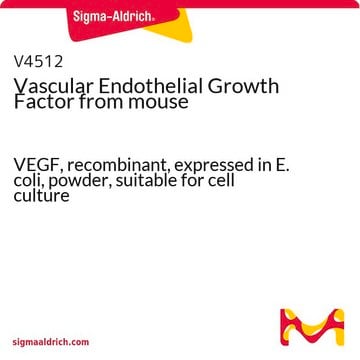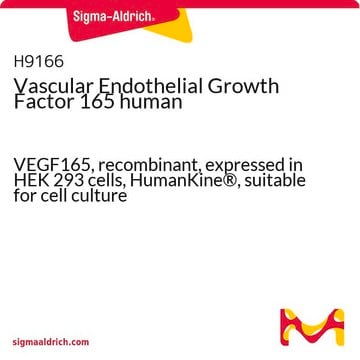GF315
VEGF165 Protein, Human Recombinant Animal Free
The Vascular endothelial growth factor (VEGF or VEGFA) is a potent mediator of both angiogenesis & vasculogenesis in the fetus & adult. Manufactured using all non-animal reagents.
Synonyme(s) :
Vascular Endothelial Growth Factor 165, VEGF-165, VEGF, Vascular Endothelial Growth Factor, VEGF-A
About This Item
Produits recommandés
Niveau de qualité
Pureté
>98% (SDS-PAGE and HPLC)
Impuretés
<0.1 μg/mg protein endotoxin (<1EU/μg)
Numéro d'accès NCBI
Numéro d'accès UniProt
Conditions d'expédition
dry ice
Catégories apparentées
Description générale
Spécificité
Mouse, Rat, Pig, Hamster, Trout, Green Algae, Sheep, Cow, Rabbit, Guinea Pig
Application
Stem Cell Research
Growth Factors & Receptors
Qualité
Forme physique
Stockage et stabilité
Clause de non-responsabilité
Code de la classe de stockage
11 - Combustible Solids
Classe de danger pour l'eau (WGK)
WGK 1
Point d'éclair (°F)
Not applicable
Point d'éclair (°C)
Not applicable
Certificats d'analyse (COA)
Recherchez un Certificats d'analyse (COA) en saisissant le numéro de lot du produit. Les numéros de lot figurent sur l'étiquette du produit après les mots "Lot" ou "Batch".
Déjà en possession de ce produit ?
Retrouvez la documentation relative aux produits que vous avez récemment achetés dans la Bibliothèque de documents.
Notre équipe de scientifiques dispose d'une expérience dans tous les secteurs de la recherche, notamment en sciences de la vie, science des matériaux, synthèse chimique, chromatographie, analyse et dans de nombreux autres domaines..
Contacter notre Service technique






